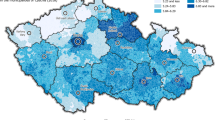Abstract
India is one the fastest growing and developing economies and also societies of the world. An evident consequence of this is urbanisation, which poses a huge challenge for the population and the political decision-makers of the country and is also one of the most topical research trends of the social geographical researches concerning India. The paper first introduces the general urbanisation trends experienced in the sovereign India in the 1951–2011 period, in the framework of an analysis of statistical data recorded in censuses, indicating the volume and trends of urbanisation. This is followed by the demonstration of the structural features and diverse development paths of the million-plus agglomerations (i.e. agglomerations with at least a million inhabitants), connected to one of its main characteristics depicted by this introductory summary: metropolisation. Using the quantitative categories defined during their analysis, the authors classify the metropolises of India in urbanisation types, with the method of cluster analysis. In what follows, we sought to answer whether any correlation could be justified between these urbanization types and the complex quality of life indicators we generated for the central settlements of the agglomerations.
The publication was supported by the University of Pécs, Szentágothai Research Centre, Research Centre of Historical and Political Geography and PADME Foundation.
Access this chapter
Tax calculation will be finalised at checkout
Purchases are for personal use only
Similar content being viewed by others
Notes
- 1.
In our interpretation megalopolises are extended and continuous urban areas having more than 10 million inhabitants.
- 2.
Urban agglomerations where the population rate of the eponymous core city within the total agglomeration reaches 97.5% or at least 95%, and at the same time the administrative area of the hinterland makes less than 5% of the territory of the total urban area, are not taken as real agglomerations.
References
Becker RA, Chambers JM, Wilks AR (1988) The new S language: a programming environment for data analysis and graphics, Wadsworth & Brooks/Cole, Monterey
Census India (2001) Census Data 2001. Office of the registrar general & census commissioner, India. https://censusindia.gov.in/2011-common/census_data_2001.html
Census India (2011) Census Data 2011. Office of the registrar general & census commissioner, India. https://censusindia.gov.in/2011-common/censusdata2011.html
Census Newsletter (2001) eCENSUS India: Issue Number 3: 2001. https://censusindia.gov.in/Census_Data_2001/Census_Newsletters/Newsletter_Links/eci_3.htm
Gower JC (1971) A general coefficient of similarity and some of its properties biometrics 27(4):857–874
Halkidi M, Batistakis Y, Vazirgiannis M (2001) On clustering validation techniques. J Intell Inf Syst (17):107–145.
Hartigan JA, Wong MA (1979) Algorithm AS 136: A K-means clustering algorithm. Appl Stat 28(1):100–108. https://doi.org/10.2307/2346830
Murtagh F, Legendre P (2014) Ward’s hierarchical agglomerative clustering method: which algorithms implement Ward’s criterion? J Classif 31:274–295. https://doi.org/10.1007/s00357-014-9161-z
Pradhan K (2017) Unacknowledged urbanisation: new census towns of India. In: Denis E, Zérah MH (eds): Subaltern urbanisation in India: an introduction to the dynamics of ordinary towns, pp 39–66 https://doi.org/10.1007/978-81-322-3616-0_2
R core team (2020) R: A language and environment for statistical computing. R Foundation for statistical computing, Vienna, Austria. https://www.r-project.org/
Ramachandran R (2001) Urbanization and urban systems of India Oxford University Press, New Delhi
Rousseeuw PJ (1987) Silhouettes: A graphical aid to the interpretation and validation of cluster analysis. J Comput Appl Math (20):53–65. https://doi.org/10.1016/0377-0427(87)90125-7
Scrucca L, Fop M, Murphy TB, Raftery AE (2016) mclust 5: Clustering, classification and density estimation using Gaussian finite mixture models. R J 8(1):289–317.
Singh N (2014) Mapping metropolises in India. Modern geográfia 2014 (3):77–94. http://www.moderngeografia.eu/?=44
Tirtha R (2002) Geography of India rawat publications, New Delhi
Towns and urban agglomerations (2011) Towns and urban agglomerations classified by population size class in 2011 With variation since 1901 office of the registrar general & census commissioner, India. https://censusindia.gov.in/2011census/PCA/A4.html
Wilhelm Z (2008) Adatok az indiai urbanizáció folyamatának vizsgálatához ModernGeográfia 2008 (2):1–57. http://www.moderngeografia.eu/?cat=22
Wilhelm Z (2011) The survey of spatial disparity in India with the application of the SENTIENT index Hungarian geographical. Bulletin 60(1):45–65
Wilhelm Z (2015) India regionális földrajza. Publikon Kiadó, Pécs
Wilhelm Z, Déri I, Szilágyi S, Nemes V, Zagyi N (2013) Urbanizáció Indiában a 2001-es, valamint a 2011-es népszámlálás előzetes eredményeinek tükrében. Településföldrajzi Tanulmányok 2 (1):60–74.
Wilhelm Z, Pete J, Nemes V, Zagyi N (2011) The survey of spatial disparity in India with the application of the sentient index with special focus on religious composition. Human innovation review 2 (1): 56–76.
Wilhelm Z, Zagyi N (2018) Történeti és jelenkori urbanizációs folyamatok Indiában. In: Pap N, Szalai G (eds) Táj geográfus ecsettel. Pécsi Tudományegyetem, Pécs, pp 119–143
Wilhelm Z, Zagyi N, Nemes V, Kiss K (2014) A gyermekkori nemi arányok átalakulásának területi összefüggései Településföldrajzi Tanulmányok 3 (1): 139–149.
Yuill RS (1971) The standard deviational ellipse: an updated tool for spatial description geografiska annaler series B. Hum Geogr 53(1):28–39
Zagyi N, Kuszinger R, Wilhelm Z (2021) Characteristics of recent urbanisation in India in light of the divergent development paths of metropolises. Reg Stat 11(3):60–94. https://doi.org/10.15196/RS110301
Author information
Authors and Affiliations
Corresponding author
Editor information
Editors and Affiliations
Rights and permissions
Copyright information
© 2022 The Author(s), under exclusive license to Springer Nature Singapore Pte Ltd.
About this chapter
Cite this chapter
Wilhelm, H.Z., Kuszinger, R., Zagyi, N. (2022). Classifying the Million-Plus Urban Agglomerations of India—Geographical Types and Quality of Life. In: Jana, N.C., Singh, A., Singh, R.B. (eds) Livelihood Enhancement Through Agriculture, Tourism and Health. Advances in Geographical and Environmental Sciences. Springer, Singapore. https://doi.org/10.1007/978-981-16-7310-8_14
Download citation
DOI: https://doi.org/10.1007/978-981-16-7310-8_14
Published:
Publisher Name: Springer, Singapore
Print ISBN: 978-981-16-7309-2
Online ISBN: 978-981-16-7310-8
eBook Packages: Earth and Environmental ScienceEarth and Environmental Science (R0)




